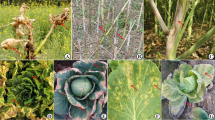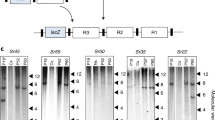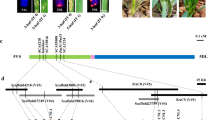Abstract
Ever since the initial discovery of the molecules and genes involved in disease resistance in plants, attempts have been made to engineer durable disease resistance in economically important crop plants. Unfortunately, many of these attempts have failed, owing to the complexity of disease-resistance signalling and the sheer diversity of infection mechanisms that different pathogens use. Although disease-resistant transgenic plants or seeds are not yet available commercially, future product development seems likely as our current level of understanding of pathogenesis and plant defence improves.
This is a preview of subscription content, access via your institution
Access options
Subscribe to this journal
Receive 51 print issues and online access
$199.00 per year
only $3.90 per issue
Buy this article
- Purchase on Springer Link
- Instant access to full article PDF
Prices may be subject to local taxes which are calculated during checkout

Similar content being viewed by others
References
Walton, J. D. Host-selective toxins: agents of compatibility. Plant Cell 8, 1723–1733 (1996).
White, F. F, Yang, B. & Johnson, L. B. Prospects for understanding avirulence gene function. Curr. Opin. Plant Biol. 3, 291–298 (2000).
Delaney, T. P. et al. A central role of salicylic acid in plant disease resistance. Science 266, 1247–1250 (1994).
Thomma, B. P., Penninckx, I. A., Broekaert, W. F. & Cammue, B. P. The complexity of disease signaling in Arabidopsis. Curr. Opin. Immunol. 13, 63–68 (2001).
Pieterse, C. M. & van Loon, L. C. Salicylic acid-independent plant defence pathways. Trends Plant Sci. 4, 52–58 (1999).
Uknes, S. et al. Acquired resistance in Arabidopsis. Plant Cell 4, 645–656 (1992).
Gorlach, J. et al. Benzothiadiazole, a novel class of inducers of systemic acquired resistance, activates gene expression and disease resistance in wheat. Plant Cell 8, 629–643 (1996).
Thomma, B. P. et al. Separate jasmonate-dependent and salicylate-dependent pathways in Arabidopsis are essential for resistance to distinct microbial pathogens. Proc. Natl Acad. Sci. USA 95, 15107–15111 (1998).
Feys, B. J. & Parker, J. E. Interplay of signalling pathways in plant disease resistance. Trends Genet. 16, 449–455 (2000).
Grant, J. J., Yun, B. W. & Loake, G. J. Oxidative burst and cognate redox signalling reported by luciferase imaging: identification of a signal network that functions independently of ethylene, SA and Me-JA but is dependent on MAPKK activity. Plant J. 24, 569–582 (2000).
Pieterse, C. M. et al. A novel signaling pathway controlling induced systemic resistance in Arabidopsis. Plant Cell 10, 1571–1580 (1998).
Stintzi, A. et al. Plant 'pathogenesis-related' proteins and their role in defense against pathogens. Biochimie 75, 687–706 (1993).
Penninckx, I. A. M. A., Thomma, B. P. H. J., Buchala, A., Metraux, J.-P. & Broekaert, W. F. Concomitant activation of jasmonate and ethylene response pathways is required for induction of a plant defensin gene in Arabidopsis. Plant Cell 10, 2103–2113 (1998).
Cao, H., Li, X. & Dong, X. Generation of broad-spectrum disease resistance by overexpression of an essential regulatory gene in systemic acquired resistance. Proc. Natl Acad. Sci. USA 95, 6531–6536 (1998).
Bowling, S. A. et al. A mutation in Arabidopsis that leads to constitutive expression of systemic acquired resistance. Plant Cell 6, 1845–1857 (1994).
Frye, C. A., Tang, D. & Innes, R. W. Negative regulation of defense responses in plants by a conserved MAPKK kinase. Proc. Natl Acad. Sci. USA 98, 373–378 (2001).
Doares, S. H., Narvaez-Vazquez, J., Conconi, A. & Ryan, C. A. Salicylic acid inhibits synthesis of proteinase inhibitors in tomato leaves induced by systemin and jasmonic acid. Plant Physiol. 108, 1741–1746 (1995).
Leslie, C. A. & Romani, R. J. Inhibition of ethylene biosynthesis by salicylic acid. Plant Physiol. 88, 833–837 (1988).
Hoffman, T., Schmidt, J. S., Zheng, X. & Bent, A. F. Isolation of ethylene-insensitive soybean mutants that are altered in pathogen susceptibility and gene-for-gene disease resistance. Plant Physiol. 119, 935–949 (1999).
Jarosch, B., Kogel, K.-H. & Schaffrath, U. The ambivalence of the barley Mlo locus: mutations conferring resistance against powdery mildew (Blumeria graminis f. sp. hordei) enhance susceptibility to the rice blast fungus Magnaporthe grisea . Mol. Plant-Microbe Interact. 12, 508–514 (1999).
Alexander, D. et al. Increased tolerance to two oomycete pathogens in transgenic tobacco expressing pathogenesis-related proteon 1a. Proc. Natl Acad. Sci. USA 90, 7327–7331 (1993).
Punja, Z. K. & Raharjo, S. H. T. Response of transgenic cucumber and carrot plants expressing different chitinase enzymes to inoculation with fungal pathogens. Plant Dis. 80, 999–1005 (1996).
Maleck, K. et al. The transcriptome of Arabidopsis thaliana during systemic acquired resistance. Nature Genet. 26, 403–410 (2000).
Hain, R. et al. Disease resistance results from foreign phytoalexin expression in a novel plant. Nature 361, 153–156 (1993).
He, X. Z. & Dixon, R. A. Genetic manipulation of isoflavone 7-O-methyltransferase enhances biosynthesis of 4′-O-methylated isoflavonoid phytoalexins and disease resistance in alfalfa. Plant Cell 12, 1689–1702 (2000).
Hipskind, J. D. & Paiva, N. L. Constitutive accumulation of a resveratrol-glucoside in transgenic alfalfa increases resistance to Phoma medicaginis . Mol. Plant-Microbe Interact. 13, 551–562 (2000).
Dorey, S. et al. Spatial and temporal induction of cell death, defense genes, and accumulation of salicylic acid in tobacco leaves reacting hypersensitively to a fungal glycoprotein elicitor. Mol. Plant-Microbe Interact. 10, 646–655 (1997).
Costet, L. et al. Relationship between localized acquired resistance (LAR) and the hypersensitive response (HR): HR is necessary for LAR to occur and salicylic acid is not sufficient to trigger LAR. Mol. Plant-Microbe Interact. 12, 655–662 (1999).
Morel, J.-B. & Dangl, J. L. The hypersensitive response and the induction of cell death in plants. Cell Death Differ. 4, 671–683 (1997).
Melchers, L. S. & Stuiver, M. H. Novel genes for disease-resistance breeding. Curr. Opin. Plant Biol. 3, 147–152 (2000).
Pink, D. & Puddephat, I. Deployment of disease resistance genes by plant transformation - a 'mix and match' approach. Trends. Plant Sci. 4, 71–75 (1999).
Joosten, M. H. A. J., Cozijnsen, T. J. & De Wit, P. J. G. M. Host resistance to fungal tomato pathogen lost by a single base pair change in an avirulence gene. Nature 367, 384–386 (1994).
Gassmann, W. et al. Molecular evolution of virulence in natural field strains of Xanthomonas campestris pv. vesicatoria . J. Bacteriol. 182, 7053–7059 (2000).
Rommens, C. M. & Kishore, G. M. Exploiting the full potential of disease-resistance genes for agricultural use. Curr. Opin. Biotechnol. 11, 120–125 (2000).
Heath, M. C. Nonhost resistance and non-specific plant defenses. Curr. Opin. Plant Biol. 3, 315–319 (2000).
Kamoun, S., van West, P., Vleeshouwers, V. G. A. A., de Groot, K. E. & Govers, F. Resistance of Nicotiana benthamiana to Phytophthora infestans is mediated by the recognition of the elicitor protein INF1. Plant Cell 10, 1413–1425 (1998).
Aarts, N. et al. Different requirements for EDS1 and NDR1 by disease resistance genes define at least two R gene-mediated signaling pathways in Arabidopsis. Proc. Natl Acad. Sci. USA 95, 10306–10311 (1998).
Parker, J. E. et al. Characterization of eds1, a mutation in Arabidopsis suppressing resistance to Peronospora parasitica specified by several different RPP genes. Plant Cell 8, 2033–2046 (1996).
de Wit, P. J. G. M. Molecular characterization of gene-for-gene systems in plant-fungus interactions and the application of avirulence genes in control of plant pathogens. Annu. Rev. Phytopathol. 30, 391–418 (1992).
Keller, H. et al. Pathogen induced elicitin production in transgenic tobacco generates a hypersensitive response and nonspecific disease resistance. Plant Cell 11, 223–235 (1999).
Govrin, E. M. & Levine, A. The hypersensitive response facilitates plant infection by the necrotrphic pathogen Botrytis cinerea . Curr. Biol. 10, 751–757 (2000).
Bonnet, P., Bourdon, E., Ponchet, M., Blein, J. P. & Ricci, P. Acquired resistance triggered by elicitins in tobacco and other plants. Eur. J. Plant Pathol. 102, 181–192 (1996).
Schafer, W. The role of cutinase in fungal pathogenesis. Trends Microbiol. 1, 69–71 (1993).
Proctor, R. H., Hohn, T. M. & McCormick, S. P. Reduced virulence of Gibberella zeae caused by disruption of a trichothecene toxin biosynthetic gene. Mol. Plant-Microbe Interact. 8, 593–601 (1995).
Johal, G. S. & Briggs, S. P. Reductase activity encoded by the Hm1 resistance gene in maize. Science 258, 985–987 (1992).
Tanaka, A., Shiotani, H., Yamamoto, M. & Tsuge, T. Insertional mutagenesis and cloning of the genes required for biosynthesis of the host-specific AK-toxin in the Japanese pear pathotype of Alternaria alternata . Mol. Plant-Microbe Interact. 12, 691–702 (1999).
Daub, M. E. & Ehrenshaft, M. The photoactivated Cercospora toxin cercosporin: contributions to plant disease and fundamental biology. Annu. Rev. Phytopath. 38, 461–490 (2000).
Cessna, S. G., Sear, V. E., Dickman, M. B. & Low, P. S. Oxalic acid, a pathogenicity factor for Sclerotinia sclerotiorum, suppresses the oxidative burst of the host plant. Plant Cell 12, 2191–2200 (2000).
Hartman, C. L., Sarjit, J. & Schmitt, M. S. Newly characterised oxalate oxidase and uses therefor. Patent application WO9214824 〈http://ep.espacenet.com〉 (1992).
Charne, D. G. et al. Production of pathogen resistant plants. Patent application WO9904012 〈http://ep.espacenet.com〉 (1999).
Kesarwani, M., Azam, M., Natarajan, K. & Datta, A. Oxalate decarboxylase from Collybia velutipes. Molecular cloning and its overexpression to confer resistance to fungal infection in transgenic tobacco and tomato. J. Biol. Chem. 275, 7230–7238 (2000).
Lauge, R. et al. Successful search for a resistance gene in tomato targeted against a virulence factor of a fungal pathogen. Proc. Natl Acad. Sci. USA 95, 9014–9018 (1998).
Gilchrist, D. G. et al. in Biology of Plant-Microbe Interactions (eds de Wit, P. J. M., Bisseling, T. & Stiekema, W. J.) 406–410 (Int. Soc. Mol. Plant-Microbe Interact., St Paul, MN, 2000).
Dickman, M. B. Trans-species transfer of apoptotic genes and transgenic plants developed thereby. Patent application WO0026391 〈http://ep.espacenet.com〉 (2000).
Acknowledgements
The authors thank all colleagues in Syngenta and especially the team at Syngenta-MOGEN for helpful discussions and suggestions, and B. van Wezenbeek for critically reading the manuscript. It is impossible to include all approaches in a complex field such as this, and we apologize to all colleagues whose work was not referred to.
Author information
Authors and Affiliations
Corresponding author
Rights and permissions
About this article
Cite this article
Stuiver, M., Custers, J. Engineering disease resistance in plants. Nature 411, 865–868 (2001). https://doi.org/10.1038/35081200
Issue Date:
DOI: https://doi.org/10.1038/35081200
This article is cited by
-
Comparative transcriptomic analysis indicates genes associated with local and systemic resistance to Colletotrichum graminicola in maize
Scientific Reports (2017)
-
Comparative susceptibility of peanut genetically engineered for sclerotinia blight resistance to non-target peanut pathogens
European Journal of Plant Pathology (2016)
-
Effector-assisted breeding for bacterial wilt resistance in horticultural crops
Horticulture, Environment, and Biotechnology (2016)
-
Molecular and cellular control of cell death and defense signaling in pepper
Planta (2015)
Comments
By submitting a comment you agree to abide by our Terms and Community Guidelines. If you find something abusive or that does not comply with our terms or guidelines please flag it as inappropriate.



